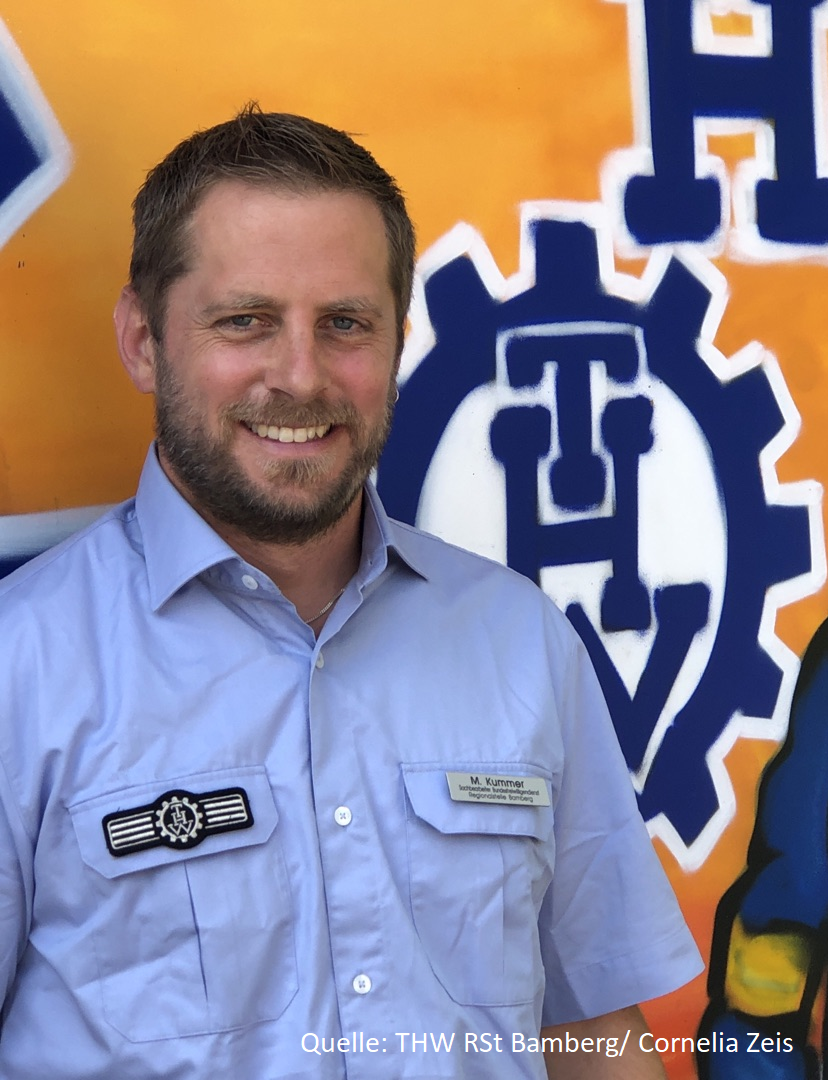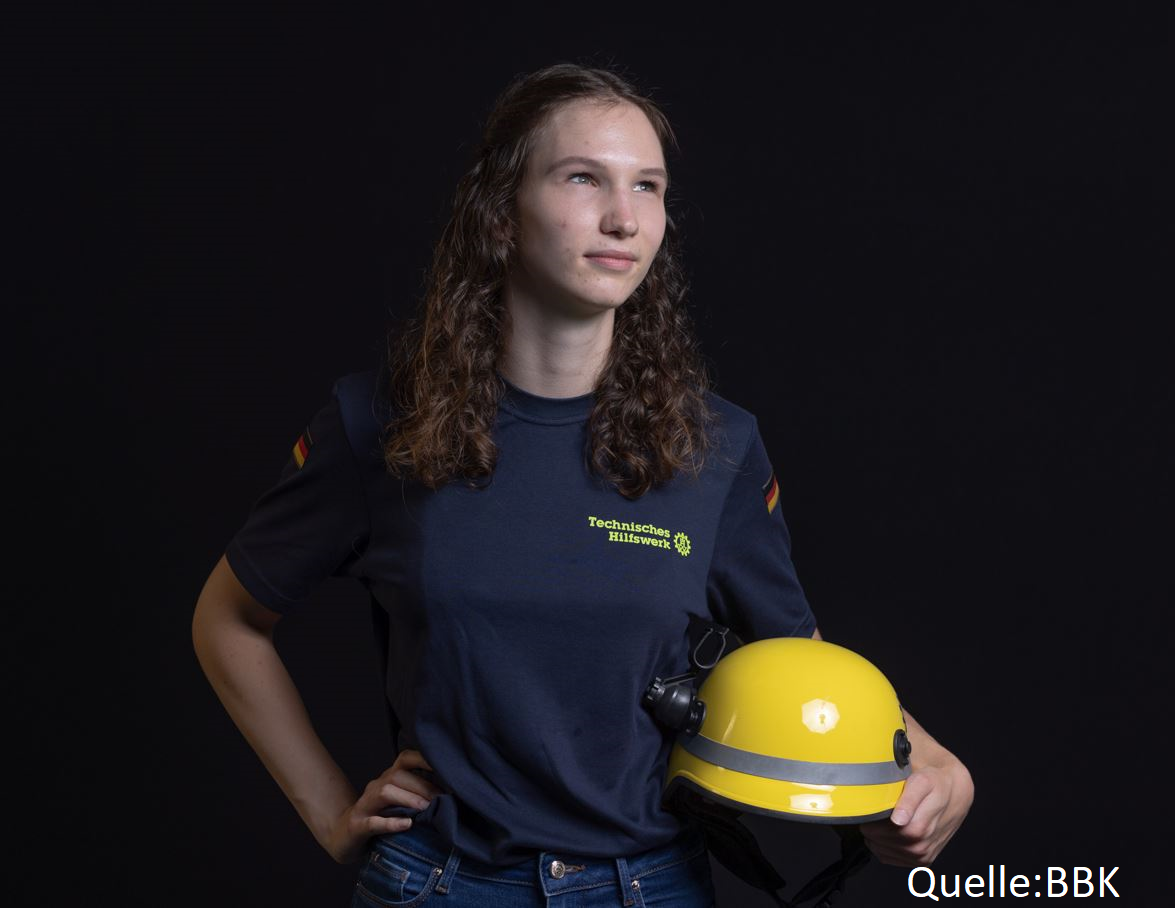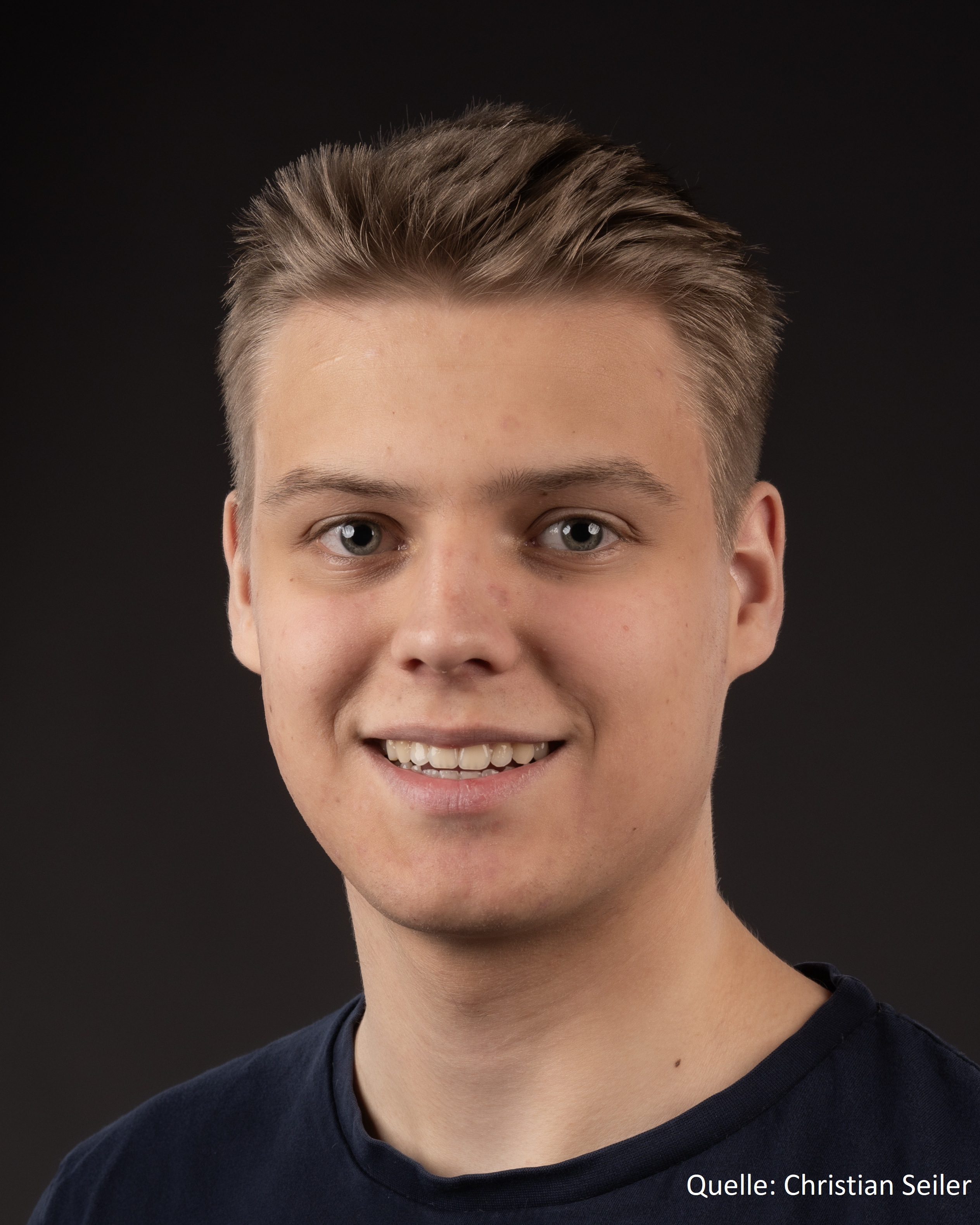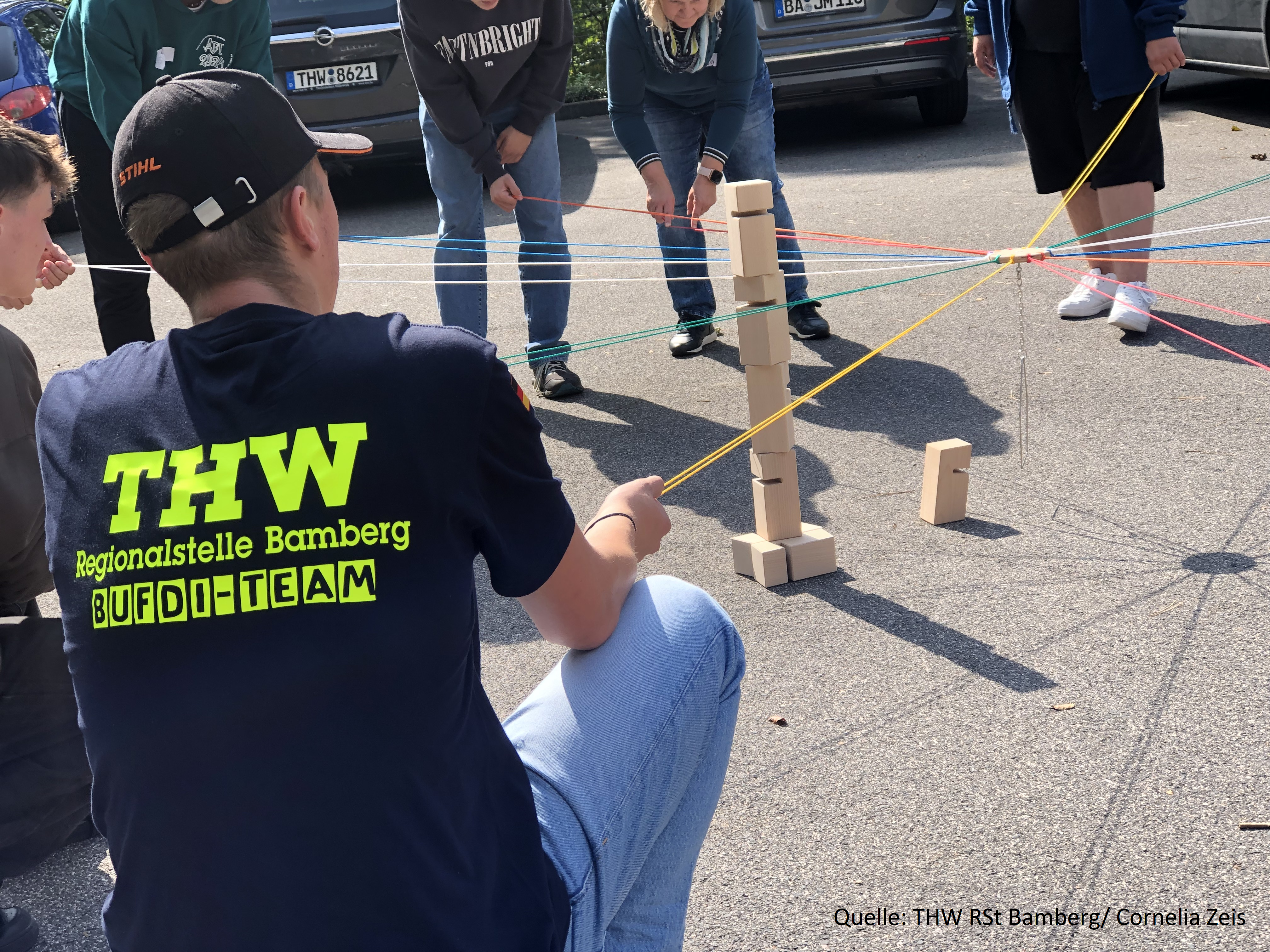06.11.2024 | Bericht, Interviews
The Federal Volunteer Service (BFD) is an easy way to get involved in Germany for a certain period of time for the common good – for example in civil protection and disaster control. We spoke to former volunteers Laura Killemann and Christian Seiler and volunteer coordinator Martin Kummer about how this works at the Federal Agency for Technical Relief (ger. Technisches Hilfswerk/ THW) and what the benefits of the BFD are.
The Federal Volunteer Service was introduced in July 2011 after compulsory military service in Germany and the associated civilian service were suspended. It is therefore possible to complete a BFD in many places where civilian service was previously possible. It usually lasts around 12 months and can be started at any stage of life after completing compulsory schooling at the age of 15 or 16.
 A growing program
A growing program
Qualified teacher Martin Kummer is head of the Federal Volunteer Service department at the THW in Bamberg. He has been working with volunteers at THW for five years. When he started there, the program was still being developed. “Before my time, there were only a maximum of two volunteers per year at the Bamberg regional office,” he recalls, ”now there are 14-15 on average.” Across Germany, the THW now has around 800 so called „Bufdis“ (name for the BFD volunteers) per year. The program has therefore grown significantly in recent years. The support situation for the volunteers has also continued to improve as a result of experience, reports Kummer. Today, in addition to a wide range of tasks, the volunteers generally expect close supervision and numerous educational opportunities.
Mostly it is the desire for orientation
The reasons why someone decides to do the Federal Voluntary Service are very diverse, reports Kummer. Mostly it is the desire for orientation after school. After leaving school, young people are initially somewhat overwhelmed by the many opportunities available to them and then decide to do something completely different for a while before starting university or an apprenticeship – not learning again straight away, but getting a taste of working life – with working hours, breaks, vacations and defined tasks. According to Kummer, some people also join the THW specifically because they want to join the professional fire department, the police or the armed forces later on.
Gaining experience in professional life
Laura Killemann also decided to do her BFD with the THW regional association in Saxony and Thuringia after leaving school because she didn’t know exactly what she wanted to do afterwards. She wanted to gain professional experience and was very interested in technology. On the recommendation of her brother, she ended up at THW. “I read up on the THW on the internet beforehand and saw what areas of work they offer and it sounded very interesting – the different areas: Administration, IT, media, technology,” she reports. After the BFD, Killemann decided to train as an orthopaedic technician. The THW helped her a lot with her decision, she says. As she was able to get a taste of various practical activities as part of the BFD, she discovered her skills in the trade and at the same time realized: “Administration is not really my thing.”
„”The next steps should already be set”
During her BFD time, Killemann was not only able to gain practical experience, she also received support with her job applications for the rest of her life, she explains. The Bufdi coordinator Kummer also emphasizes: “When the BFD ends, the connection should ideally already be ‘in dry cloths’ (german saying). The volunteers are therefore also supported in their career orientation. He believes it is important to “pack a rucksack for all volunteers during their year, which will help them later on”. The BFD therefore also includes numerous educational opportunities – from political, social and cultural education to practical training. However, all volunteers are given the opportunity to complete the THW basic training as part of the BFD. They can then take this with them for later – both as experience and as a qualification. Driving safety training, first aid courses or even a forklift license can also be completed as part of the BFD. If they wish, the volunteers leave the year with a “whole packet of certificates”, explains Kummer. These are practical and verifiable experiences that could be enriching for many young people’s CVs.
 BFD is also a good choice for bridging the gap
BFD is also a good choice for bridging the gap
For Christian Seiler, it was not so much uncertainty about his future career path that led to his decision to do the BFD with the THW, but rather the desire to fill the time between the end of school and his apprenticeship with a meaningful activity. “I decided relatively late after school not to go straight to university because I wanted to do an apprenticeship after all. However, the apprenticeship places for 2023 were already gone and I couldn’t start my apprenticeship until 2024. So I thought: I’ll just do a voluntary service in the meantime.” Christian Seiler is now training to become a mechatronics engineer. He says he was particularly interested in the technical aspects of the TWH, “that I can learn a lot of technical things that will also help me with my training. I was interested in the fact that I could do something practical. And I found it exciting to get to know the THW better because I didn’t know much about it.”
What does a volunteer do – lots of things.
When asked “What does a volunteer do at THW?”, all three give us the same answer: the tasks are varied – as varied as the volunteers themselves. In the last five years, all age groups from 16 to 65 have been involved, reports Kummer. Then you have to look – “Is this someone who is fresh out of school and would like to get a taste of different activities and learn something? Or is it someone who is about to retire and would simply like to be a bit of support, for example in administration or would like to get to know something new than his or her previous job description?” The interests and skills of the individual volunteers therefore play just as much a role as the location, as the BFD can be completed at the THW management, in the regional offices, in the regional offices or even in the volunteer-run local associations. Depending on where you end up, the tasks that volunteers can take on change. The tasks range from repairs and equipment testing to driving services and support at events through to public relations work and administrative tasks – so an interest in technology is not absolutely necessary if you want to complete the BFD with the THW.
Normal working days and special moments
The BFD day is designed like a normal working day, describes Laura Killemann. “You arrive in the morning, greet your colleagues, ask if anyone has any tasks for you and whether you can help somewhere.” One task in particular sticks in her mind: “At the end of my federal voluntary service, we helped out at a state youth camp in 2022 at Leipzig-Altenburg Airport in the municipality of Nobitz, and I was allowed to help with the preparation, follow-up and implementation. It was great to see the whole thing for myself and to see the logistical effort involved.” She has particularly fond memories of the happy faces of the young people who took their performance badge at the national youth camp.
„No two days were ever the same“
Christian Seiler also describes his tasks as varied: “Some things were repetitive, but there were no two days that were the same, it was really very varied.”
During his BFD, he worked at the Bremen regional office. The regional offices are subordinate to the management and the eight regional associations. There are 66 regional offices in the THW organization. Each regional office in turn coordinates around ten local associations. Seiler worked in the Bremen regional office as part of the “audit team”. This team inspects the materials in each of the ten local branches every year. For around two weeks, he was involved in the inspection in each local association. “Those were long days,” he recalls, as the team always drove from the regional office to the local association in the morning and back again in the evening. During these two weeks, he got to see a lot of the day-to-day work in the local associations. When he wasn’t out and about with the inspection team, his tasks were varied, he remembers: “You arrived in the morning and then did what you had to do.” In addition to testing equipment, his tasks also included transporting equipment from the regional office to the local associations and vice versa, programming Excel spreadsheets here and there, designing a patch for the volunteers and vehicle maintenance: “That didn’t come up so often, but it also involved doing things like changing tires. That was also very interesting because I personally hadn’t done that before. It’s not rocket science, but it was cool. These are things that always help in life if you can do them.”
Independence and self-confidence
Seiler particularly remembers the moment when he completed his THW basic training – and held his certificate in his hands. He went to the training center in Brandenburg an der Havel three times for a week each time. But it wasn’t just technical knowledge that helped him, the BFD also helped him personally, says Seiler: “The fact that you simply become much more independent, that you have to work on tasks on your own, that you go somewhere on your own and do something. You become much more self-confident – that kind of thing really helped me a lot with my personal development.” Seiler can highly recommend the BFD at the THW regional office, because there was always something to do. “It was a strange feeling when it was over,” he says today, shortly after the end of his voluntary service. He really enjoyed the time.
Do volunteers later become volunteers?
How many volunteers went on to become THW volunteers? About half, Kummer estimates. Of the 73 volunteers who have completed a BFD in his regional office in the last five years, around 80% have also registered as volunteers in a local association. Around half of them have also remained in the local association after their BFD. So for many of them, the BFD really is their first step into volunteering. However, Kummer emphasizes that it is of course also okay if you don’t want to continue after the BFD. The exact number of people who stay with the THW after their BFD is not easy to determine, because many people move to other cities after their BFD, for example to study, and then continue working in a THW local association there. “We actually see this all the time now,” says Kummer, that helpers ‘come to THW from other cities with their qualifications and say: I did my Federal Voluntary Service here and there and am already joining you as a qualified helper’. Or they get to know THW through the BFD and then initially have other priorities such as finding a career or planning a family. And then, when they have more time again, they become volunteers. Anything is possible.
Doing good and being happy yourself
Laura Killemann also stayed with THW as a volunteer after her BFD. “I realized that I wanted to make a difference, help out and you can also feel the sense of cohesion at THW and I wanted to be a part of that.” Why should others also consider the BFD? “You can work for the common good in Germany, get to know lots of new people and have exciting experiences,” reports Killemann. Today, the THW has also become a kind of family for her, which gives her support in bad moments. “I can do good in my voluntary work and be happy at the same time, which motivates me,” she says.